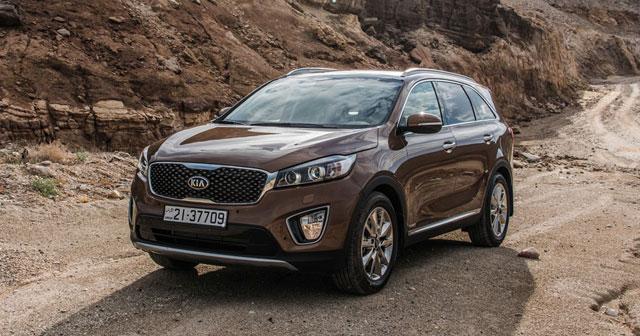You are here
Consistent evolution
By Ghaith Madadha - Dec 29,2014 - Last updated at Dec 29,2014

With accelerated model development and update cycles, Kia is becoming ever more responsive to customer requirements and changing trends, and has blurring the lines between a mid-life facelift and an all-new model. Though longer than the car it replaces, the 2015 Kia Sorento at first seems like an update.
However, subtle but extensive mechanical, technological, design and interior enhancements go as far as a new bodyshell and add up to a considerably better vehicle. And with markedly improved ride, handling, refinement and luxury, the 2015 Sorento more accurately constitutes an all-new car that goes from an also-ran when relaunched as a 7-seat crossover SUV in 2009 to a world-class vehicle.
More than skin deep
Gaining 95mm in length, of which 80mm constitute a longer wheelbase, the new Sorento benefits from improve ride quality, cabin space and being 10mm lower and 5mm wider, gains a greater sense of road presence. Re-engineered to utilise 52.7 per cent ultra-high tensile steel and 10.1 per cent ultra-strong hot-stamped steel compared to its predecessor’s 24.4 per cent and 4.1 per cent, the new Sorento offers a 14 per cent improvement in torsional rigidity for improved refinement, handling and safety.
In addition to a stiffer core structure being notably improved at the wheel-arches, pillars, tailgate, the new Sorento also receives a 29 per cent thicker dashboard, improved transmission tunnel sound-proofing and larger engine and gearbox mounts for added refinement and 3-6 per cent noise reduction.
Evolutionary in spirit, the new Sorrento’s styling however seems significantly sportier and more up-market. Dominated by a new front-end with moody wrap-around headlights with LED elements and upward far-side kinks, the 2015 Sorento’s wider, hungrier interpretation of Kia’s “Tiger Nose” corporate face includes a diamond honeycomb pattern similar to the 2013 Kia Cross GT concept.
A bigger bumper with metal skid plate-like lower panel, large trapezoidal fog-lights and wide lower intake combine with a clamshell bonnet with scalloped edges for a more powerful road presence. Similarly, the longer Sorento features a lower roofline and higher waistline, but retains its thick D-pillar. More conservative rear lights and sportier bumper design look more elegant.
Smooth delivery
Offered with two petrol engine choices in Jordan, the driven top-of-the-range 3.3-litre V6 with conventional multi-port fuel injection develops 266BHP at 6400rpm and 234lb/ft torque at 5300rpm. Driven through a 6-speed automatic gearbox, the Sorento’s ‘over-square’ engine can haul the 1,733kg family SUV to 100km/h in 8.2-seconds, onto 210km/h and returns 10.5l/100km combined fuel efficiency.
Reflecting the Sorento’s primary role as a refined on-road car-like crossover SUV, its high-revving V6 is progressive in delivery and power build-up, and allows for responsive throttle control to dialling in exact power increments as required. The 3.3-litre engine has also been improved to yield more low-end torque for improved flexibility in daily driving and on inclines.
Smooth-shifting with responsiveness and shift points altered depending on which of three driving mode settings one chooses from economy to sportiness, the Sorento’s 6-speed automatic can be sequentially shifted through the gear lever, but there are no steering-mounted buttons or levers.
Well-spaced ratios served well for performance and economy, but on particularly high and steep inclines, one felt that a little more low-end torque, or a slightly more aggressive second gear ratio would have aided momentum through tight briskly driven corners, but by no means essential. Larger drivers might find the gear lever set slightly close on the centre console, especially when using sequential “manual” shift mode with lever angled towards driver.
Composure and comfort
Offered in front- or part-time four-wheel drive versions as driven during the Sorento’s regional launch held in Jordan last month, torque is ostensibly sent to the front wheels, with rear wheels receiving more torque as required for to maintain traction, grip and balance.
At low speeds, 50:50 four-wheel drive can be locked for improved ability and predictability, while an Advanced Traction Cornering Control (ATCC) system transfers more torque to the outside rear wheel while braking the inside wheel for enhance grip through hard corners. Designed to operate before the electronic stability controls step in, the Sorento’s ATCC system allowed for fluency and natural handling characteristics, when driven on a gravely low traction rally stage.
With better ride and handling, the new Sorento’s longer wheelbase lends itself to greater highway stability and cornering grip. Retaining its predecessor’s front MacPherson and rear multi-link suspension set-up, the new Sorento’s larger dampers — vertically located behind the rear axles — and larger sub-frame bushes provide better ride compliance and body control.
Through rough rural switchbacks the new Sorento cornered more confidently and with better poise and weight transfer control, while road imperfections were dispatched with buttoned-down composure on rebound. Faster and with more feel, the Sorento’s modified electric-assisted steering turns in with more positive, quick and direct feel, and is fluently weighted and assisted, but is also reassuringly stable at speed.
Space and refinement
Turning in and holding cornering lines tidily, the new Sorento is agile and keen for its segment. Highway stability is reassuring and refined, and benefits from low CD0.33 aerodynamic drag and underfloor cover. Comfortable in most situations with the largest alloy wheels and lowest profile 235/55R19 tyres, the Sorento was firmly smooth over all but the harshest potholes.
More pliant standard 235/65R17 or optional 235/60R18 tyres should provide even more comfortably supple ride qualities. Spacious inside, the new Sorento features improved headspace for all three rows, with the longer wheelbase mainly translating into added middle row legroom and longer seat sliding versatility. Luggage room improves from 258-litre minimum and 2052-litre maximum to 320-lires and 1066-litres respectively.
Practical, convenient and refined inside, the new Sorento features a more aesthetic interior design themed to emphasise its width, while upholstery and materials are also improved, with soft textures covering the most important areas occupants interact with.
Well-kitted, the Sorento features extensive standard and optional creature comforts including an automatic opening tailgate, 10-way adjustable driver’s seat, panoramic roof and 7- or 8-inch infotaiment screen with around-view parking assist cameras. Scoring a maximum five-star EuroNCAP safety rating, the Sorento’s numerous safety features include modern active driver-assistance systems like adaptive cruise control, lane departure and assistance systems, blind-spot warning and Rear Cross-Traffic Alert, which warns of other cars driving behind when parking.
Technical specifications
Engine: 3.3-litre, transverse V6-cylinders
Bore x stroke: 92 x 83.8mm
Compression ratio: 10.6:1
Valve-train: 24-valve, DOHC
Gearbox: 6-speed automatic, four-wheel-drive
Gear ratios: 1st 4.651:1; 2nd 2.831:1; 3rd 1.842:1; 4th 1.386:1; 5th 1:1 6th 0.772:1
Reverse/final drive: 3.393:1/3.320:1
Power, BHP (PS) [kW]: 266 (270) [199] @ 6400rpm
Power-to-weight: 153.5BHP/tonne
Torque, lb/ft (Nm): 234 (318) @ 5300rpm
Torque-to-weight: 183.5Nm/tonne
0-100km/h: 8.2-seconds
Top speed: 210km/h
Fuel consumption, combined: 10.5-litres/100km
CO2 emissions, combined: 245g/km
Length: 4,780mm
Width: 1,890mm
Height: 1,690mm
Wheelbase: 2,780mm
Track, F/R: 1,633/1,644
Ground clearance: 185mm
Approach/ramp/departure angles: 16.9°/18°/21°
Aerodynamic drag co-efficiency: 0.33
Legroom, 1st/2nd/3rd row: 1048/1,000/805mm
Luggage volume, min/max: 320/2,066-litres
Kerb weight: 1,733kg
Steering: Electric-assisted rack & pinion
Lock-to-lock: 2.87-turns
Suspension, F/R: MacPherson struts/multi-link, coils, anti-roll bar
Brakes, F/R: 320mm ventilated discs/305mm discs
Tyres: 235/55R19
Related Articles
A thoroughly better appointed, equipped and designed vehicle than it has ever been since its 2002 introduction, the Kia Sorento has over the
A car-like SUV, the crossover segment’s origins are difficult to pin down.
On the market since 1993 and before the compact crossover became a runaway success and distinct automotive segment.



















